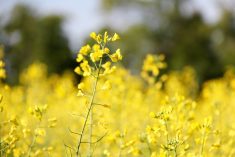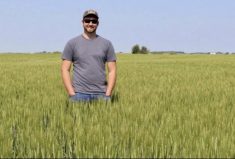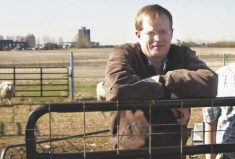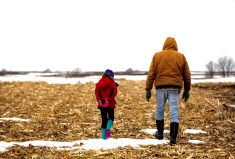It pays to think ahead when planting a shelterbelt.
The first step is site selection, said Jeff Renton of the Agroforestry and Woodlot Extension Society, a joint venture of government, industry, and conservation agencies that promotes stewardship and offers extension services.
The site needs proper setbacks from homes, roads, crops, and utilities.
“Know where the right-of-way allowances are and plant away from them,” said Renton. “Be sure to check with your county and find out where the rights-of-way are and the distance requirements you will need to keep in mind.”
Read Also

New crop insurer policy enables easier startup for faba beans
Agriculture Financial Services Corporation updated its normals for faba beans, which may open the door for more Canadian producers to feel comfortable growing the pulse crop in the future.
Do not plant directly underneath power lines.
“If you do, those trees are going to have to be pruned regularly in order to not interfere with the power line,” he said. “Most trees with one leading single stem don’t do well being pruned annually.”
To find out if there are utilities underground, contact Alberta One-Call at 1-800-242-3447 or via albertaonecall.com. As well, don’t plant shallow-rooted trees such as spruce or poplar near a septic field.
A general rule of thumb for a single-row shelterbelt is to make sure the setback is twice the shelterbelt’s height from its leeward — or downwind — side from a road or a field to accommodate the length of the snowdrift.
“If a single-row shelterbelt is on the north end of a road where the winds would traditionally be going, there will generally be snowdump of up to twice the height of the tree,” said Renton. “If there are five rows, for example, there won’t really be much of a snowdump because most of that snow is going to be absorbed within the shelterbelt.”
One shelterbelt does not fit all, so determine your goals before deciding how many rows to plant.
“For a crop where protection from snow is most important, one to three rows of deciduous species is most appropriate,” he said. “For protecting livestock or infrastructure or people in a farmyard, three to five rows with a mixture of deciduous or coniferous species would be best.”
Renton recommends a setback distance equal to or more than the height of the shelterbelt.
“There are several reasons for this,” he said. “You want to reduce the snowdrift that’s going to wind up on the leeward side. It’s also important to think from a fire safety and overall damage perspective.”
The groundwork
Proper site preparation saves a lot of work later.
Soil compaction, competition from above- and below-ground vegetation, and excessive soil moisture should be taken into account.
Renton emphasizes the need for mulching.
“If you do not use mulch or some other kind of barrier, expect to do a lot of weeding and mowing,” he said. “For the first three to five years after planting, weeds and herbaceous species in general are going to be very strong competitors of trees and shrubs.”
For large shelterbelts, Renton strongly recommends plastic mulch. The ground will have to be tilled several times to make it smooth and level enough to roll out the plastic, but it’s worth the effort, he said.
“It offers a huge time savings — some weeds can still get through the holes and that requires some weeding, but in general very little weeding is required. Because it’s black and plastic it keeps up the soil temperature, making it a lot more productive especially in the longer growing season.
“Plastic mulch really shines in moisture retention as well. Be sure to apply when there is adequate soil moisture so that there is not a long lag time in soil moisture migrating to the plastic.”
One hurdle involved with plastic mulch is the equipment expense, but your municipality may be able to help.
“Counties often have plastic mulch applicators for rent. It’s a disc-based applicator pulled by a tractor or skid steer that lays the plastic mulch over the planting.”
Assistance available
Shelterbelts are not cheap. Renton estimates the cost of a four-row, half-acre, quarter-mile shelterbelt at around $3,000 including labour, equipment, and seedlings. However, that number can vary wildly.
“It really depends on what you’re working with,” he said. “Tillage and glyphosate application can bring up the overall costs considerably. But having the equipment and time to do it yourself can really bring costs down.
“The primary cost is the seedlings. For example, if you want 500 spruce per half-mile, that alone costs around $500.”
The good news is there is financial help available. Producers who have completed an Environmental Farm Plan (EFP) are eligible for 50 per cent cost-share financing through the Growing Forward 2 On-Farm Stewardship Program, which offers up to $10,000 for creating shelterbelts. Renton urges producers to investigate what other programs they might be eligible for and find out if there is any assistance offered by their municipalities.
“For riparian areas, which are a type of shelterbelt, there’s a 70 per cent cost-share program available. Some counties provide some kind of subsidy such as bulk ordering or seed giveaways.”
The Agroforestry and Woodlot Extension Society has articles on shelterbelts, plastic mulch, and other topics on its website.
















